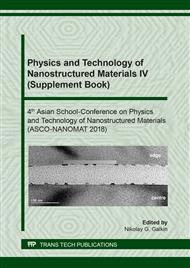[1]
E.A. Loria. Gamma titanium aluminides as prospective structural materials, Intermetallics. 8 (2000) 1339-1345.
DOI: 10.1016/s0966-9795(00)00073-x
Google Scholar
[2]
H. Clemens, H. Kestler. Processing and applications of intermetallic γ-TiAl-based alloys, Advanced Engineering Materials. 2 (2000) 551-570.
DOI: 10.1002/1527-2648(200009)2:9<551::aid-adem551>3.0.co;2-u
Google Scholar
[3]
Titanium and Titanium Alloys: Fundamentals and Applications. Edited by C. Leyens, M. Peters. Wiley, (2003).
Google Scholar
[4]
X.F. Ding, J.P. Lin, L.Q. Zhang, Y.Q. Su, G.L. Chen. Microstructural control of TiAl-Nb alloys by directional solidification, Acta Materialia. 60 (2012) 498-506.
DOI: 10.1016/j.actamat.2011.10.009
Google Scholar
[5]
P. J. Maziasz, R. V. Ramanujan, C. T. Liu, J. L. Wright. Effects of B and W Alloying Additions on the Formation and Stability of Lamellar Structures in Two Phase γ-TiAl, Intermetallics. 5 (1997) 83-95.
DOI: 10.1016/s0966-9795(96)00070-2
Google Scholar
[6]
D. J. Larson, C. T. Liu, M. K. Miller. Tungsten segregation in α2+γ titanium aluminides, Intermetallics. 5 (1997) 497-500.
DOI: 10.1016/s0966-9795(97)00026-5
Google Scholar
[7]
K. Hashimoto, H. Hirata, Y. Mizuhara. Phase Stability and High Temperature Tensile Properties of W doped gamma-TiAl, Mat. Res. Soc. Symp. Proc. 646 (2011) N7.8.1.-N7.8.6.
DOI: 10.1557/proc-646-n7.8.1
Google Scholar
[8]
Y. Zheng, L. Zhao, K. Tangri, Microstructure evolution during heat treatment of a Cr-bearing Ti3Al+TiAl alloy, Scr. Metall. Mater. 26 (1992) 219-224.
DOI: 10.1016/0956-716x(92)90176-f
Google Scholar
[9]
E. Hamzah, M. Kanniah, M. Harun, Effect of chromium addition on microstructure, tensile properties and creep resistance of as-cast Ti-48Al alloy, J. Mater. Sci. 42 (2007) 9063-9069.
DOI: 10.1007/s10853-007-1692-9
Google Scholar
[10]
F. Appel, D. Herrmann, F.D. Fischer, J. Svoboda, E. Kozeschnik. Role of vacancies in work hardening and fatigue of TiAl alloys, International Journal of Plasticity, 42 (2013) 83-100.
DOI: 10.1016/j.ijplas.2012.10.001
Google Scholar
[11]
F. Ruicheng, C. Hui, L. Haiyan, R. Zhiyuan, Y. Changfeng. Effects of Vacancy Concentration and Temperature on Mechanical Properties of Single-Crystal γ-TiAl Based on Molecular Dynamics Simulation, High Temp. Mater. Proc. 37 (2018) 113-120.
DOI: 10.1515/htmp-2016-0156
Google Scholar
[12]
X. Gonzea, B. Amadond, P.-M. Angladee, J.-M. Beukena, F. Bottind, P. Boulangera, F. Brunevalq, D. Calistej, R. Caracasl, M. Côtéo, T. Deutschj, L. Genovesei, Ph. Ghosezk, M. Giantomassia, S. Goedeckerc, D.R. Hamannm, P. Hermetp, F. Jolletd, G. Jomardd, S. Lerouxd, M. Mancinid, S. Mazevetd, M.J.T. Oliveiraa, G. Onidab, Y. Pouillona, T. Rangela, G.- M. Rignanesea, D. Sangallib, R. Shaltafa, M. Torrentd, M.J. Verstraetea, G. Zerahd and J.W. Zwanziger, ABINIT: First-principles approach to material and nanosystem properties, Computer Phys. Comm. 180 (2009) 2582-2615.
Google Scholar
[13]
M. Fuchs, M. Scheffler, Ab initio pseudopotentials for electronic structure calculations of polyatomic systems using density functional theory, Comp. Phys. Commun. 119 (1999) 32-67.
DOI: 10.1016/s0010-4655(98)00201-x
Google Scholar
[14]
A. Gnidenko. Computer Simulation of Plastic Deformation in TiAl Alloys in the Presence of Chromium, Defect and Diffusion Forum. 386 (2018) 383-387.
DOI: 10.4028/www.scientific.net/ddf.386.383
Google Scholar
[15]
Y. Song, Z. X. Guo, R. Yang. First principles studies of TiAl-based alloys, J. Light Met. 2 (2002) 115-123.
Google Scholar
[16]
C. Jiang. First-principles study of site occupancy of dilute 3d, 4d and 5d transition metal solutes in L10 TiAl, Acta Materialia. 56 (2008) 6224-6231.
DOI: 10.1016/j.actamat.2008.08.047
Google Scholar
[17]
Shared Facility Center Data Center of FEB RAS, (Khabarovsk), http://lits.ccfebras.ru.
Google Scholar


